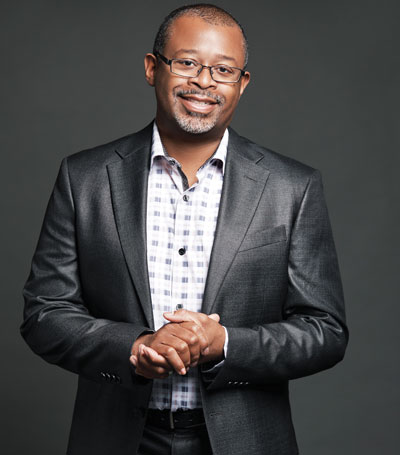James Lee III

- Born: 1975 in St. Joseph, Michigan
Breaths of Universal Longings
- Composed: 2022
- Premiere: This performance is the work’s world premiere.
- Instrumentation: SATB chorus, SATB youth chorus, 2 flutes, 2 oboes, 2 clarinets, 2 bassoons (incl. contrabassoon), 4 horns, 2 trumpets, 3 trombones, tuba, timpani, bass drum, chimes, congas, crash cymbals, egg shaker, glockenspiel, suspended cymbals, tam-tam, tambour de Basque, temple blocks, tenor drum, tom-tom, triangle, wind chimes, wood block, harp, strings
- Duration: approx. 28 minutes
James Lee III, born in 1975, graduated with a Doctor of Musical Arts degree from the University of Michigan in 2005. Lee’s orchestral works have been commissioned and premiered by the National Symphony, Detroit Symphony, Baltimore Symphony, Chicago Symphony, Boston Symphony, St. Louis Symphony, and the orchestras of Philadelphia, Cincinnati, Atlanta and others. His works have been conducted by Leonard Slatkin, Marin Alsop, Michael Tilson Thomas, Juanjo Mena and others. In October of 2021, Amer’ican was premiered by the Detroit Symphony, and Niiji Memories, his flute concerto, was premiered by Julietta Curenton and the Columbia Orchestra. In November of 2021, the Calyx Piano Trio premiered Tones of Clay at Tanglewood, and the St. Louis Symphony performed Emotive Transformations. Other world premieres that season included Freedom’s Genuine Dawn, which was premiered by the Baltimore Symphony in January 2022. A Double Standard for Karen Slack and the Pacifica String Quartet was premiered in June of 2022 at Carnegie Hall and Shriver Hall. Premieres scheduled for the 2023–24 season include a piano concerto, an English horn concerto, and an orchestral work.
James Lee III wrote of Breaths of Universal Longings:
Breaths of Universal Longings is a work in four movements that is inspired primarily by the concepts of joy and belonging. It is a work that celebrates the power of the voice and singing. It is also about shared humanity and the universality of singing. The first movement, “From Dust We Were Made,” employs biblical texts from Genesis 2:7, and Job 38:7 in which I paraphrased the words written. The initial idea is that mankind was created from the dust of the ground, the breath of life was breathed into humanity’s nostrils, and then man (and woman) become living beings that would rise, and joyfully sing as the morning stars also sang together and all of creation shouted for joy! Movement two, “Now and Then,” was written by Charles Bertram and is a reflection on a long life lived and a comparison of the actions in one’s youth with the last years of one’s life. The following strophe from the poem illustrates the sentiments of the poet: “To life’s sun-setting years, My feet have come—Alas! And through its hopes and fears, again I shall not pass.” There are contrasting episodes of music that alternate with the unifying melodic passages on the texts “All life is built from song” and “All life is built from love.” As the work continues, the third movement, “Reflection,” utilizes texts written by members of the May Festival Youth Chorus. This movement includes texts that search for joy, singing, longing and belonging. The music from this movement was partially inspired by the aftermath of being in mandatory lockdowns and quarantines during the Covid-19 crisis of 2020 and 2021. A beautiful part of the texts used in this movement comes from the words “Into this day we must rise as a sun, out from this darkness to shine.” The last movement, “Seeking Joy,” uses texts from William Henry Davies’ poem with the same name. The music here continues in a steady ascent from a thin texture of tranquility that seeks to musically convey the opening words, “Joy, how I sought thee!” As the texts continue to expand on the acts of an individual searching for joy in various places and not being fulfilled, the music comes to a decisive change in course with the words “Joy, I have found thee!” Then, the music continues to bring forth passages of joy, glee, awe, and exuberance in an increasingly dense texture until the last explosive measure.